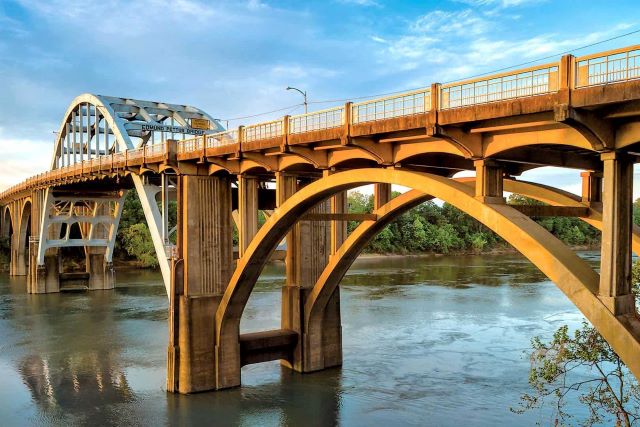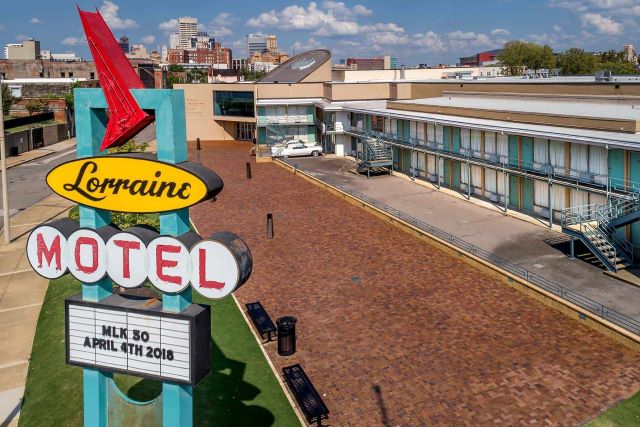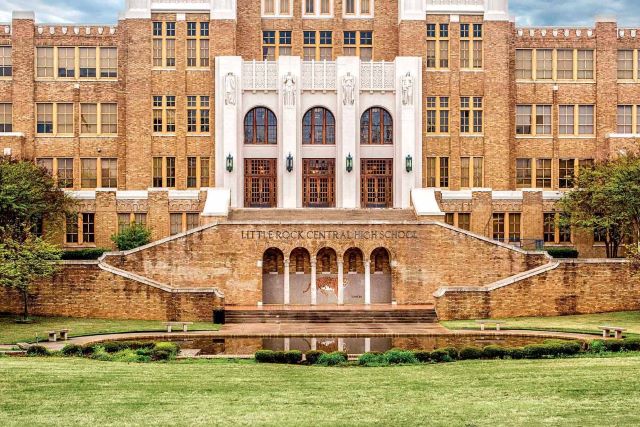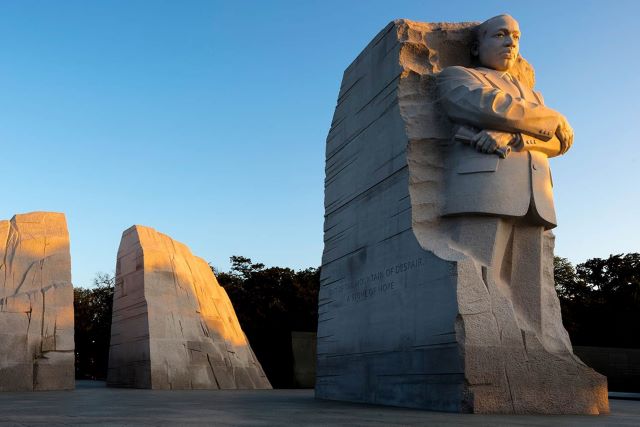The Civil Rights Movement was one of the most transformative times in American history. It would be impossible to summarize its significance in a single museum, or honor its participants’ efforts with a sole monument. Fortunately, there is the U.S. Civil Rights Trail to do just that.
Created in 2018, the trail guides visitors to more than 100 locations across 14 states. It was created through the combined efforts of several official state tourism agencies. Joining all these locations into a single trail helps highlight the breadth and significance of the Civil Rights Movement.
“For too long the churches, courthouses and schools where significant civil rights activity had occurred were ignored or otherwise unappreciated,” said Lee Sentell, director of the Alabama Tourism Department. “Linking the historic places focused a spotlight to honor the contributions that courageous activists had made at great personal risk.”
The U.S. Civil Rights Trail has also sparked tourism in the Southern states. “Since the U.S. Civil Rights Trail was launched, most of the 140 sites have experienced substantial growth in the number of visitors seeking to learn more about the history of the movement,” Sentell said. “Equally important, those Southern states that hadn’t previously developed a trail highlighting their heritage landmarks have now done so.”
Here are some of the U.S. Civil Rights Trail’s most noteworthy destinations.
Alabama
Birmingham
The 16th Street Baptist Church – still an active church today – served as a meeting place for organizations participating in marches and other civil rights activities. In 1963, the church was bombed, killing four young girls. The event spurred the government to act on civil rights legislation.
The Alabama city is also home to the Birmingham Civil Rights Institute. The 58,000-square-foot museum features a rendition of a 1950s segregated city, a replica of a Freedom Riders bus and the actual door from the jail cell that housed King when he wrote his famous “Letter From Birmingham Jail.”
Montgomery
Alabama’s capital city was one of the epicenters of the Civil Rights Movement. It is justly well-represented on the trail. The Dexter Avenue King Memorial Church was the first church where King served as a pastor. It also hosted meetings that led to the Montgomery Bus Boycott.
The Rosa Parks Museum is located at the site where Parks boarded a public bus and was arrested. The Freedom Bus Museum is found at the bus station where Freedom Riders were attacked in 1961. Take a virtual tour.
Montgomery is also home to the Civil Rights Memorial Center and National Memorial for Peace and Justice. The former serves as a tribute to all those who died during the Civil Rights Movement, and the latter is a memorial recognizing the thousands of lynchings that occurred across the country during this time.

Selma
The most iconic site in Selma is the Edmund Pettus Bridge. The National Historic Landmark was the site of the first march for voting rights on March 7, 1965. Unfortunately, the location became etched in history due to the brutal beatings of marchers that took place that day in a conflict that became known as Bloody Sunday. The events were televised across the country. This prompted public support for civil rights activists and the voting rights campaign.

Tennessee
Memphis
The Lorraine Motel holds a solemn place not only in the Civil Rights Movement, but also in the collective history of the country. The site of King’s assassination is now part of the National Civil Rights Museum. This collection of historic sites tells the story of the movement from the 17th century to present day.

Arkansas
Little Rock
Little Rock drew the eyes of the country in September 1957. Following the decision in Brown v. Board of Education, Arkansas Gov. Orval Faubus called in the Arkansas National Guard to block nine black students from entering Central High School. President Dwight D. Eisenhower sent federal troops to protect the students and allow them to enter. Eventually, the Little Rock Nine were all admitted in what was a major milestone in the fight to integrate schools.
Although it’s still in operation today, the museum and visitor center located across the street offers tours of the high school. There is also a memorial to the Little Rock Nine at the Arkansas state Capitol.
Georgia
Atlanta
Martin Luther King Jr. was born in Atlanta in 1929 and the city has been sure to honor its native son. The National Historic Site named in King’s honor consists of his childhood home, where he lived the first 12 years of his life, and the Ebenezer Baptist Church, where he was baptized, ordained and served as co-pastor with his father until 1968.
The King Center is the burial site for both King and his wife Coretta Scott King. It also houses many of King’s papers.
Also of note in Atlanta is the Center for Civil and Human Rights. This multicultural center includes exhibits highlighting the civil rights and modern human rights movements.
Robert Tyrone Patterson Sr. Interview Greensboro, NC from U.S. Civil Rights Trail on Vimeo.
North Carolina
Greensboro
Greensboro is home to the former Woolworth department store, site of one of the most critical events in the movement. In February 1960, four students from the North Carolina Agricultural and Technical State University sat at the counter and ordered coffee but were refused service. The four remained sitting until the store closed. Over the ensuing days, the sit-in grew to include more than 300 students and nearby businesses. It spurred a widespread movement of peaceful demonstration across the country.
Woolworth’s has since been incorporated into the International Civil Rights Center & Museum. The lunch counter and four seats the students occupied the remain in their original positions. A monument of the four students sits on the North Carolina A&T campus.
Washington, D.C.
The nation’s capital has numerous sites that honor the civil rights movement. Most notably is the National Museum of African American History and Culture. Opened in 2016, the Smithsonian Institution museum contains 36,000 artifacts and is the only national museum dedicated entirely to the African-American experience.
The Martin Luther King Jr. Memorial, a 30-foot stone sculpture, was dedicated in 2011. The monument made King the first African-American to be honored with a memorial on the National Mall.
Are you planning on traveling to a few of these different landmarks? Click here to rent a car. AAA members can save on Hertz rentals.
Plan your next trip with a AAA travel advisor.
Have you been to any of these sites? Tell us about it in the comments below.
This article has been updated and republished from a previous version.
12 Thoughts on “Travel the U.S. Civil Rights Trail”
Leave A Comment
Comments are subject to moderation and may or may not be published at the editor’s discretion. Only comments that are relevant to the article and add value to the Your AAA community will be considered. Comments may be edited for clarity and length.














I have always wanted to go on this trip. Please send me more details about the trip. Thank you.
Recently visited Memphis and the Civil Rights Museum. It was incredible to see, hear, and feel the energy and emotion of the time surrounding Martin Luther King’s assassination. Also in Memphis, and historically significant of injustice are the Stax Museum of American Soul Music, Sun Records (a museum and working recording studio), and Beale Street (including the restored home of the ‘Father of the Blues’, W.C. Handy and much more. All play a role in civil rights. I purchased the autobiography of W.C. Handy, available upon touring Mr. Handy’s home. So much rich history.
A visit to Memphis should be on everyone’s mind if we are to continue to raise awareness and not lose this part of civil rights history.
The African Burial Grounds in NYC is a very moving experience. We visited during Covid and the museum inside wasn’t open unfortunately, but the outdoor memorial was deeply moving and meaningful. There is good signage and information there to visit in a self-guided way. It is built on the spot where people of African ancestry had to bury their dead outside city limits at the time (now in the financial district) because cemeteries weren’t integrated. It honors and celebrates the African diaspora and spiritual traditions, and tells the story of passage to the Americas. Definitely bring kids, but be sure to let them know ahead of time that it’s a sacred and special place where where people come to commune with and honor their ancestors (rambunctious kids can mar the experience a bit).
Hopefully included on the list is a stop in Mobile to learn about the last slave ship and the story of its survivors and descendants.
https://api.nationalgeographic.com/distribution/public/amp/culture/2019/05/clotilda-the-last-american-slave-ship-found-in-alabama
Hi there!
What an amazing story … and one that definitely deserves to be read. Thanks for posting and reading!
-Dana
What an interesting story, thank you for sharing it
It is of vital importance that the younger generation knows about the struggles, where we are coming from, and were we are going. Very well done.
Travel with a meaningful purpose … Thank-you!
The trail you describe hits many significant sites but does it reflect the scope and depth of the movement? Knoxville, Tenn., is not mentioned but that is where I landed in March 1963 after discharge from the USMC. I went there to enroll at the University of Tennessee. When I went to Byerly’s Cafeteria demonstrators outside had signs saying it did not serve blacks. I picked up a sign and marched. Time and again we were attacked and jailed especially outside the Tennessee Theatre. Ironically it was showing “To Kill a Mockingbird” that our black friends could not see. What impressed me most were not we young people jailed but rather older blacks who put up their homes as guarantees to free us. The best among us were the students of Knoxville College — mostly black women — who were irrepressible. After city fathers passed a public accommodations law some demonstrators moved on to Danville, W.V., but I decided to stick to my schooling. As your travelers pass between big cities on your trail, they might ask what civil rights activities took place in small towns and cities. They will be astonished.
Thank you for your comments. I hope some young people see them. Our history is so important.
Thank you so much for sharing your story
Very nice write up about the civil rights movement and trail. Thank you for being so informative.